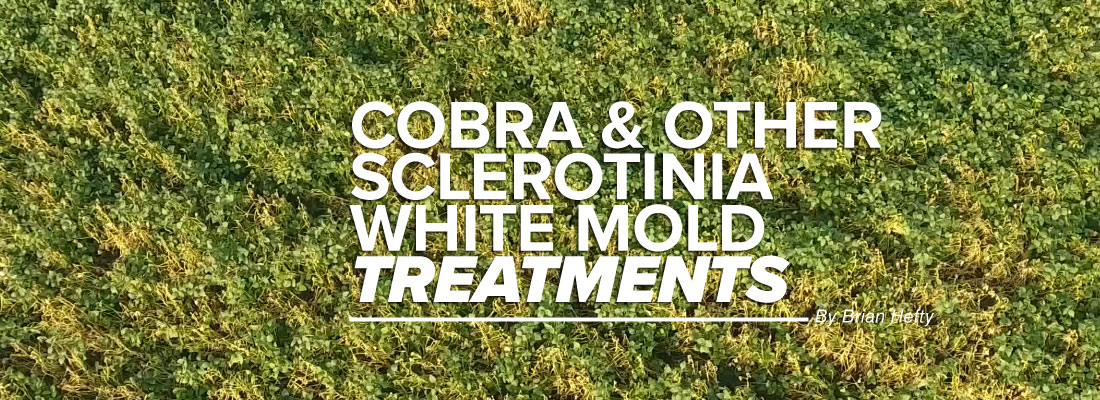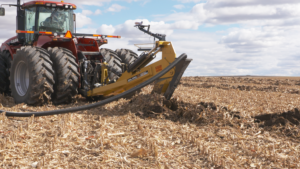
Sclerotinia white mold is the worst disease you can get in soybeans and many other crops. Even on our farm, we have had spots of zero due to white mold in soybean fields where everything else averaged 90. That’s a big loss!
Here’s the number one thing I want you to know about white mold…
If you try only one strategy to prevent white mold, you will fail. This disease has no cure, so you need to attack it from several angles. If your seed is already planted, you can’t pick a more tolerant variety or use Heads Up Seed Treatment anymore, and it’s now too late to build up your soil’s manganese levels or apply the biological product Contans to eat the sclerotia, but here is a list of things you can still do to reduce this issue on your farm.
WARRANT ULTRA OR ANTHEM MAXX
There is no label for this, and it’s not a huge help, but anything that will control your weeds – and more importantly, shorten the soybeans slightly – can slightly reduce white mold problems.
COBRA
These first two items are just for soybeans, not most of the other crops affected by white mold. Whether you believe Cobra has fungicidal properties or if it’s just the fact that soybean plants will be stunted and likely drop some leaves, Cobra provides almost as much control on white mold as the very best fungicides. In my opinion, Cobra is way undersold. It really helps on white mold, and Cobra is actually not too bad on some of the Roundup-resistant weeds, including ragweed and kochia. If all you want is white mold suppression (not a huge amount of weed control), you can run with a reduced rate of just 6 ounces per acre, which should only cost you around $5 to $7 per acre after the Bayer Plus rebates. Where we’ve had white mold spots in the past, we are definitely going to spray some Cobra right before flowering, so around June 20-25.
MANGANESE
I mentioned manganese earlier, as it is a proven fact that good manganese levels in all crops means better tolerance to sclerotinia white mold. My suggestion is to soil test your traditionally worst areas for white mold. I’ll bet you’ve got a manganese issue. Ideally, I’d like to see you broadcast some manganese sulfate this fall and add some manganese to your starter program, but you can also do some foliar feeding with manganese chelate. Try at least a little bit, but be on the early side (before flowering), rather than after white mold has already set in.
IMPROVE YOUR DRAINAGE

White mold is more likely to thrive in areas with poor drainage. Correcting this issue with tile will help improve control of this disease.
Have you noticed how white mold is typically worse in poorly drained areas? White mold starts as a mushroom, so if you can reduce the likelihood that mushrooms will grow, you will have less disease. This may sound crazy, but after planting is actually a great time to tile. We have long days, warm temps, dry soil, good traction, and you know exactly where tile is needed the most right after you just got done planting. Our suggestion is to tile up until your crop (whatever crop that is) is 1 foot tall. Up until that point, your odds of having yield loss from tiling incrop are slim.
SPRAY FUNGICIDE EARLY AND OFTEN
Foliar fungicides only protect the leaves they come in contact with. As new leaves emerge, they will be unprotected. That’s why spraying and respraying again in 3 weeks or so is important, and a third spray may be necessary roughly 6 weeks after your first application. The other issue with that is spray coverage. If you don’t get fungicide on the lowest leaves of the plant, you aren’t getting the full value out of your fungicide. This year, we will be experimenting with hanging tubes between the rows with spray nozzles that shoot sideways. Unlike with herbicide that you are trying to shoot down onto weeds, all you need with a fungicide is coverage on the crop. We will let you know how our trials go with this new spray system.
WHICH FUNGICIDES ARE BEST?
ENDURA (GROUP 7)
This is definitely the best product, and it’s labeled in many crops. The problem is it costs over $30 per acre. Where we see this fitting well is if you have bad fields or bad areas within fields that can be spottreated using a variable rate map to shut the sprayer on and off. If you are going to use Endura, the timing we prefer is early. In soybeans, for example, that’s R1 (first flower) and definitely before you see any white mold in the field.
PROLINE (GROUP 3)
This is the best triazole for white mold. If you are in the Bayer Plus program, you could pay as little as $8 for the 5 ounce soybean rate on a net basis. In dry beans, use 5.7 ounces per acre.
TALARIS (GROUP 1) + ANDIAMO (GROUP 3)
Combining the active ingredients found in Topsin and Domark respectively, this is my favorite two-way combo because it’s cheap and fairly effective. Use the full rate of each – 20 ounces of Talaris plus 5 ounces of Andiamo – for a total cost of around $13. To get the same active ingredients in a premix, you can use Acropolis.
APROACH (GROUP 11)
I still have farmers who tell me they have liked this product, but I’ve never seen it do much to white mold. I would not recommend it, in part because it’s expensive, but I don’t like any of the strobilurin products for this disease.
